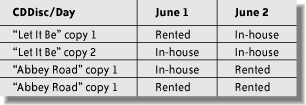3.11. The Spreadsheet Conundrum
The spreadsheet is an analogy for many design decisions you make during development. Consider the data on a spreadsheet, as shown in Figure 3-1. If you were to store the data in a linear manner in a file, you would need to decide whether to store the data by row or by column. Perhaps storing it by row seems most natural. What if programs that require the data in column order access it later? Row order makes that access inefficient.
Figure 3-1. Spreadsheet of CDDiscs and days

If you knew that future programs were going to use column order, you should have considered that in your initial code. However, if you cannot reasonably foretell in what order data will be accessed, you cannot worry too much now how it should be stored. Just document your assumptions and later on, if you have to change your approach, you will at least know why you did it the other way.
Many facets of programs parallel the spreadsheet. For example, string resources and languages form a spreadsheet such as that shown in Figure 3-2.
Figure 3-2. Spreadsheet of resources and languages

Typically the data in Figure 3-2 is stored with strings stored sequentially for each language. If you will be adding more languages, having the data stored in that manner makes sense. However, if ...
Get Prefactoring now with the O’Reilly learning platform.
O’Reilly members experience books, live events, courses curated by job role, and more from O’Reilly and nearly 200 top publishers.

